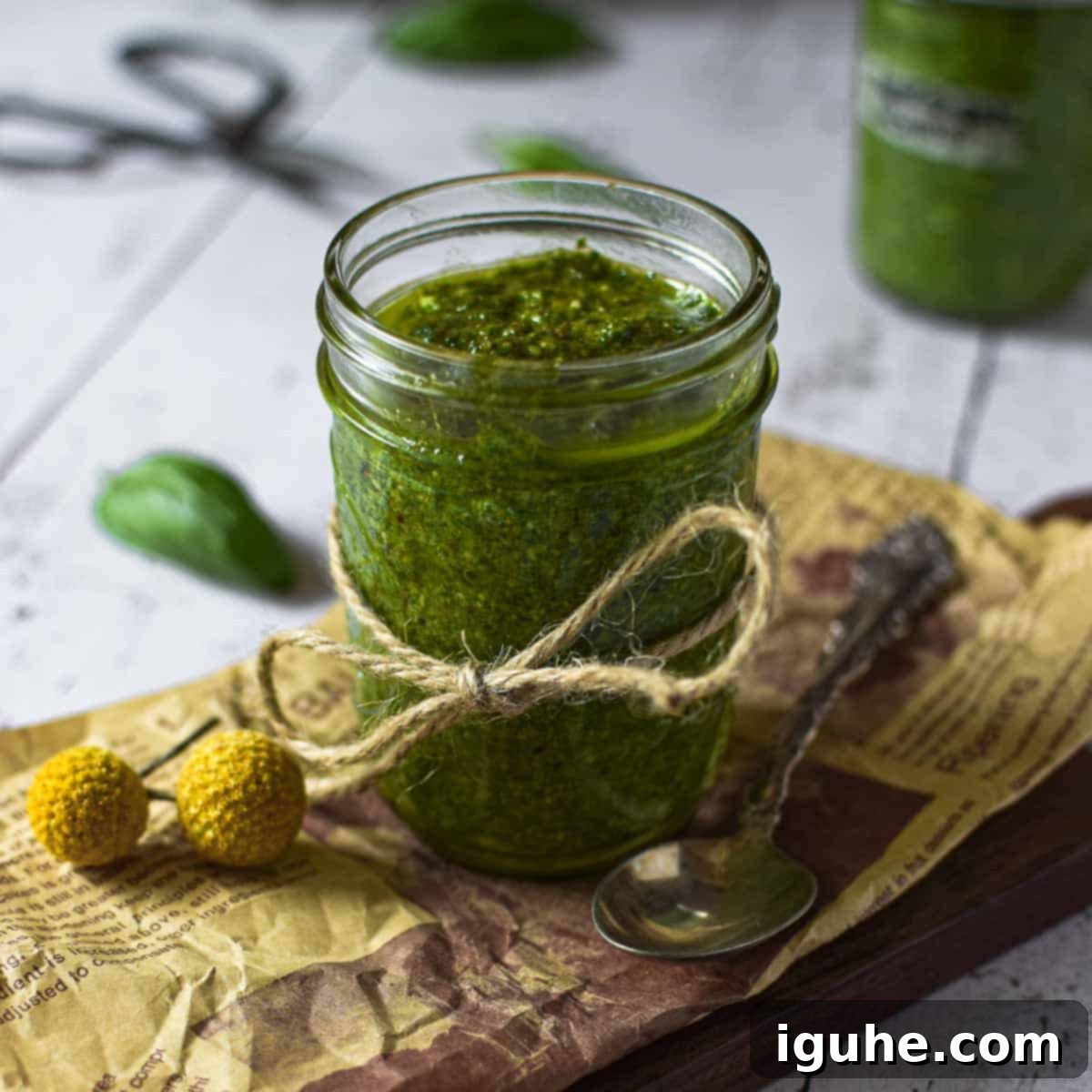Roasted Garlic Pesto: The Ultimate Creamy, Mellow Pesto Sauce Recipe
Prepare to elevate your culinary experience with this incredible Roasted Garlic Pesto Sauce. Unlike traditional pesto that uses raw garlic, this recipe features oven-roasted garlic, transforming a simple ingredient into a creamy, smooth, and intensely flavorful powerhouse. The roasting process caramelizes the garlic, mellowing its sharp bite and infusing the pesto with a rich, nutty sweetness that is truly irresistible. This milder version is perfect for anyone sensitive to raw garlic and eliminates any concerns about garlic breath, making it a crowd-pleaser for every occasion. Once you taste this delectable creation, you’ll find yourself wanting to put it on absolutely everything!
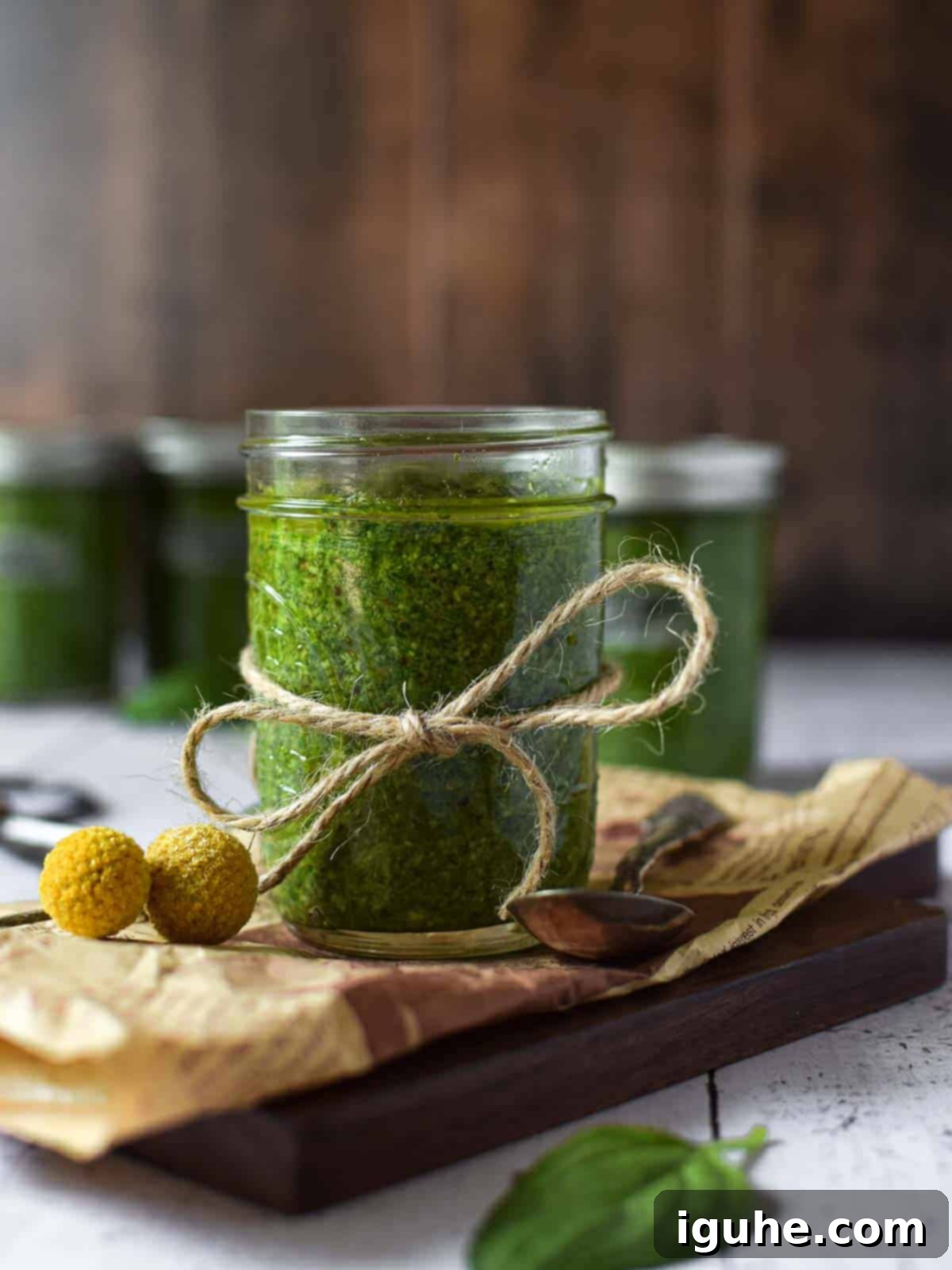
For many, homemade pesto sauce is synonymous with summer. The peak of basil season, typically in late summer, offers an abundance of fragrant leaves, making it the perfect time to whip up large batches. We love freezing it in small portions, ensuring we can enjoy its vibrant flavor long after the warm weather fades. Making pesto is surprisingly simple – a few fresh ingredients and a whirl in the food processor, and you’ve got a versatile sauce ready to transform any meal.
While classic Italian pesto traditionally features raw garlic, its pungent flavor isn’t always agreeable to everyone’s palate. The beauty of this roasted garlic variation lies in its ability to transform the garlic. Roasting mellows the sharp, sometimes overwhelming taste of raw garlic, making it significantly easier to digest and imparting a delightful sweetness. The result is a richer, more complex flavor profile without the intensity, or the lingering “garlic breath” often associated with raw garlic.
A fantastic bonus is that roasted garlic itself is incredibly versatile and can substitute raw garlic in countless recipes. Its soft, spreadable texture and creamy, nutty, and smooth flavor are rich and complement an array of dishes. Imagine it paired perfectly with succulent meats, delicate fish, hearty soups, homemade pizzas, and so much more. So, don’t hesitate – make a big batch of this roasted garlic pesto today. You truly won’t regret it!
[feast_advanced_jump_to]
What is Pesto? A Culinary Journey
Pesto, derived from the Italian word “pestare” meaning “to crush” or “to pound,” is a renowned Italian sauce originating from the Liguria region of Italy, specifically Genoa. At its heart, authentic Genovese pesto is a vibrant green sauce composed of fresh basil, aromatic garlic, toasted pine nuts, hard cheese (typically Parmigiano-Reggiano or Pecorino Sardo), and rich olive oil, all seasoned with a touch of salt. Traditionally, these ingredients are meticulously crushed together using a marble mortar and a wooden pestle, a method believed to best preserve the basil’s delicate aroma and prevent oxidation.
However, in modern kitchens, the convenience of a food processor has become the go-to method for creating this beloved sauce. This makes the process incredibly fast and accessible, allowing home cooks to enjoy fresh pesto without the labor-intensive crushing. While basil pesto remains the most iconic and common variety, the world of pesto has expanded dramatically. Today, you’ll find an endless array of creative pesto variations, incorporating greens like kale, spinach, arugula, or even sun-dried tomatoes, roasted red peppers, or cilantro. Each variation offers its unique flavor profile, but all share the ease of preparation and the delicious versatility that makes pesto a culinary staple.
Gather Your Ingredients for Exceptional Pesto
Crafting the perfect roasted garlic pesto begins with selecting high-quality ingredients. Each component plays a vital role in achieving that rich, balanced flavor and creamy texture.
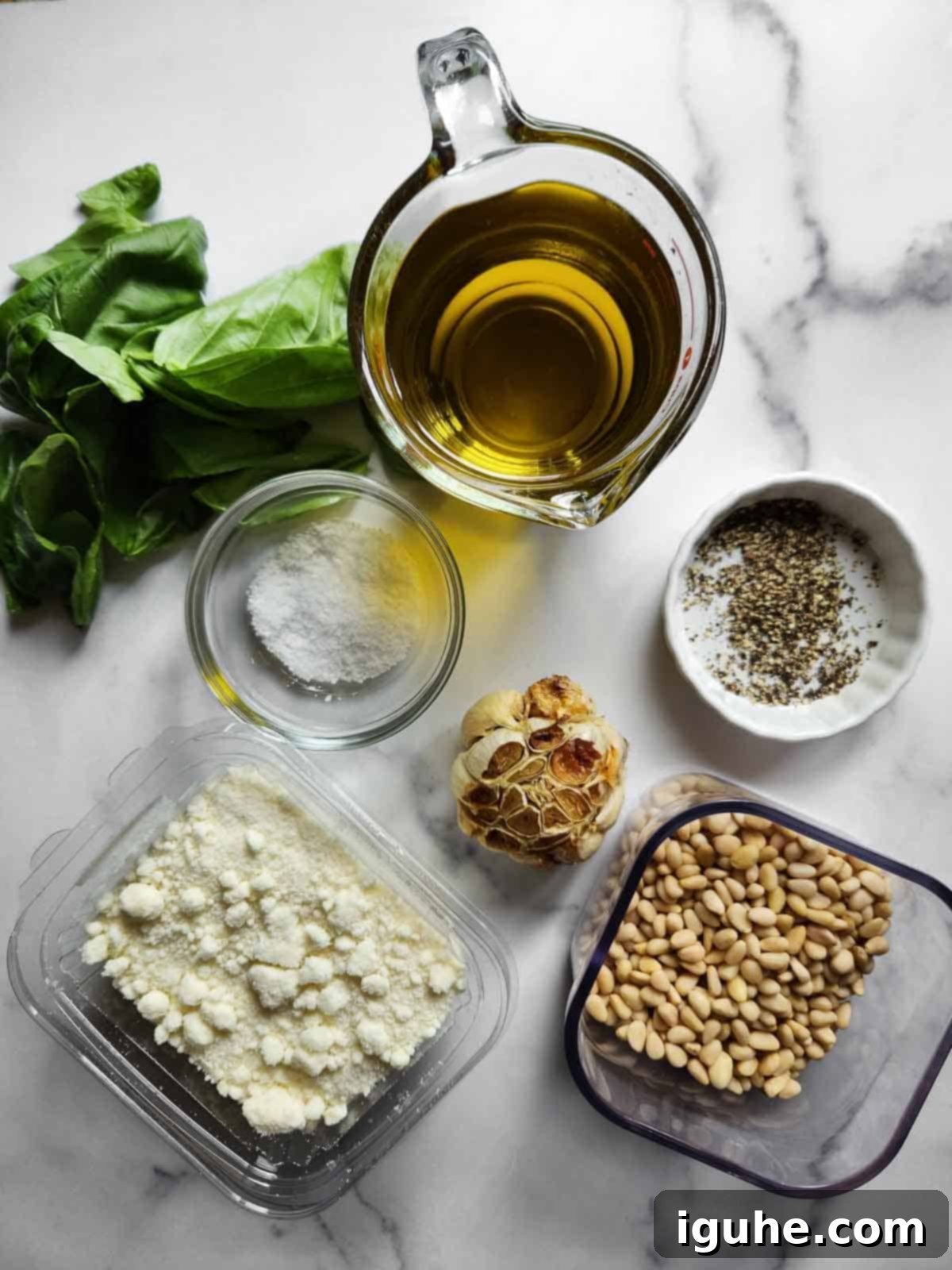
- Fresh Basil: This is the star of the show. Choose vibrant, green basil leaves without any wilting or black spots. For the best flavor, use garden-fresh basil if possible. Loosely packed leaves help ensure you get the right volume.
- Roasted Garlic: The game-changer in this recipe! Instead of raw garlic, you’ll first roast whole heads of garlic in the oven. This process transforms the pungent cloves into soft, sweet, and caramelized morsels, imparting a deep, mellow flavor to your pesto that’s easily digestible and free of raw garlic’s harshness.
- Grated Hard Cheese: Parmesan (Parmigiano-Reggiano) is the traditional choice and offers a salty, umami depth. However, feel free to experiment with other hard Italian cheeses like Locatelli or Pecorino Romano for a sharper, tangier profile. A combination of cheeses can also add complexity. Always grate your cheese fresh for the best flavor and texture.
- Nuts: Pine nuts are classic for their delicate, buttery flavor, but they can be quite expensive. For a more budget-friendly or adventurous option, walnuts, pecans, or pistachios work wonderfully and contribute their unique nutty notes. To significantly enhance their flavor, I highly recommend toasting the nuts lightly before adding them to the food processor. This brings out their oils and intensifies their aroma. You can even sometimes find pre-toasted nuts for added convenience.
- Extra Virgin Olive Oil: The quality of your olive oil truly matters here. Opt for a good quality extra virgin olive oil with a bold, fruity flavor. It not only provides the silky texture for your sauce but also adds to the overall richness and aroma.
- Salt and Pepper: Simple Kosher or fine sea salt and freshly ground black pepper are essential for seasoning. Always add to taste, as the saltiness from the cheese can vary.
Essential Equipment for Pesto Perfection
Making roasted garlic pesto doesn’t require a lot of specialized kitchen tools, making it accessible for most home cooks. Here’s what you’ll need:
- Aluminum Foil: This is crucial for properly roasting your garlic. Wrapping the garlic head in foil creates a steamy environment that softens the cloves and helps them caramelize beautifully without burning.
- Food Processor or Blender: While traditional pesto is made with a mortar and pestle, a food processor is your best friend for speed and convenience. It effortlessly blends all the ingredients into a smooth, consistent sauce. For this recipe, making a small batch of pesto, a food processor is often preferred over a large blender due to its blade design which is better suited for chopping and processing thicker mixtures. However, a high-speed blender can also work if you don’t have a food processor, though you might need to add a bit more olive oil or scrape down the sides more frequently to achieve the desired consistency.
Step-by-Step: How to Make Roasted Garlic Pesto Sauce
Making this pesto is a straightforward process, with the extra step of roasting the garlic being incredibly rewarding for the depth of flavor it provides. Follow these simple steps to create your own delicious batch:
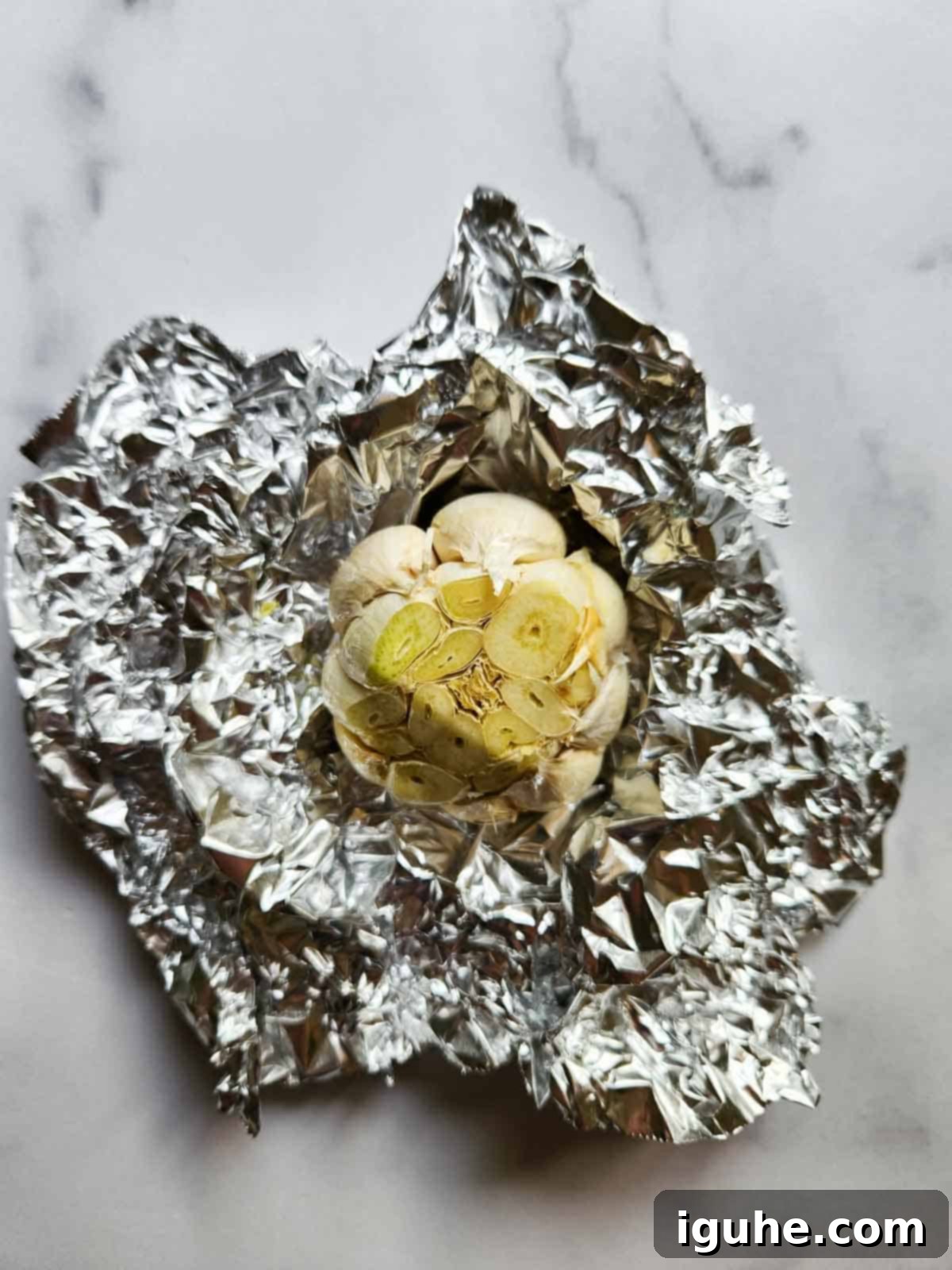
1. Prepare the Garlic for Roasting: Preheat your oven to 425℉ (220℃). Take a whole head of garlic and gently remove most of the loose, papery outer skin, but keep the head intact. Using a sharp knife, carefully slice about ¼ to ½ inch off the top of the garlic head, exposing the tips of the individual cloves. This allows the olive oil and heat to penetrate. Drizzle generously with olive oil, ensuring the exposed cloves are well coated. Wrap the entire garlic head snugly in aluminum foil to create a sealed packet. This ensures the garlic steams and roasts evenly.
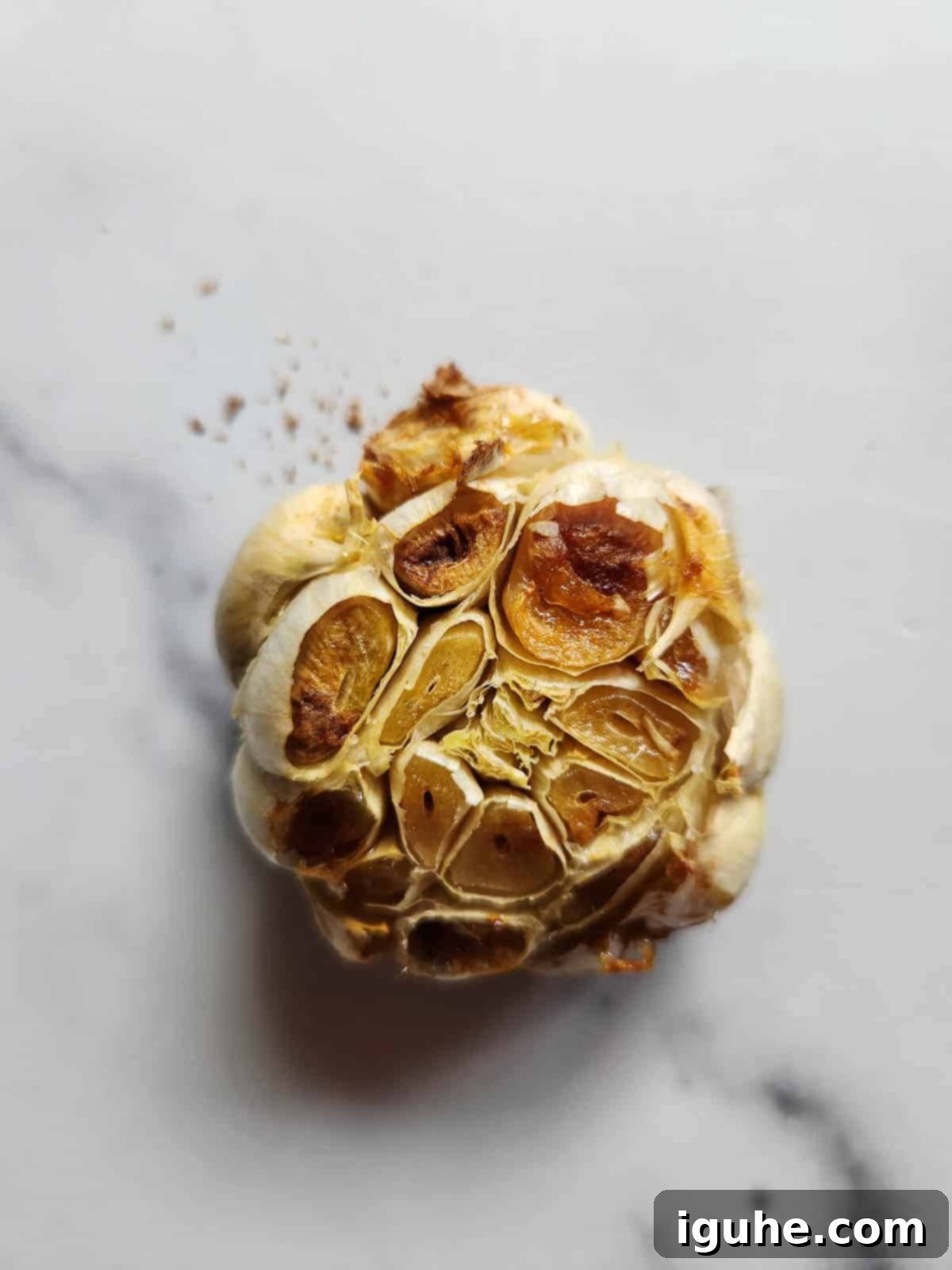
2. Roast the Garlic: Place the foil-wrapped garlic directly on the oven rack or on a small baking pan. Roast for 40-50 minutes, or until the cloves are wonderfully golden brown, completely soft when squeezed, and beautifully caramelized. The exact time can vary depending on your oven and the size of the garlic. Once roasted, remove from the oven and allow it to cool slightly within the foil. This cooling period makes it easier to handle and continues to mellow the flavors.
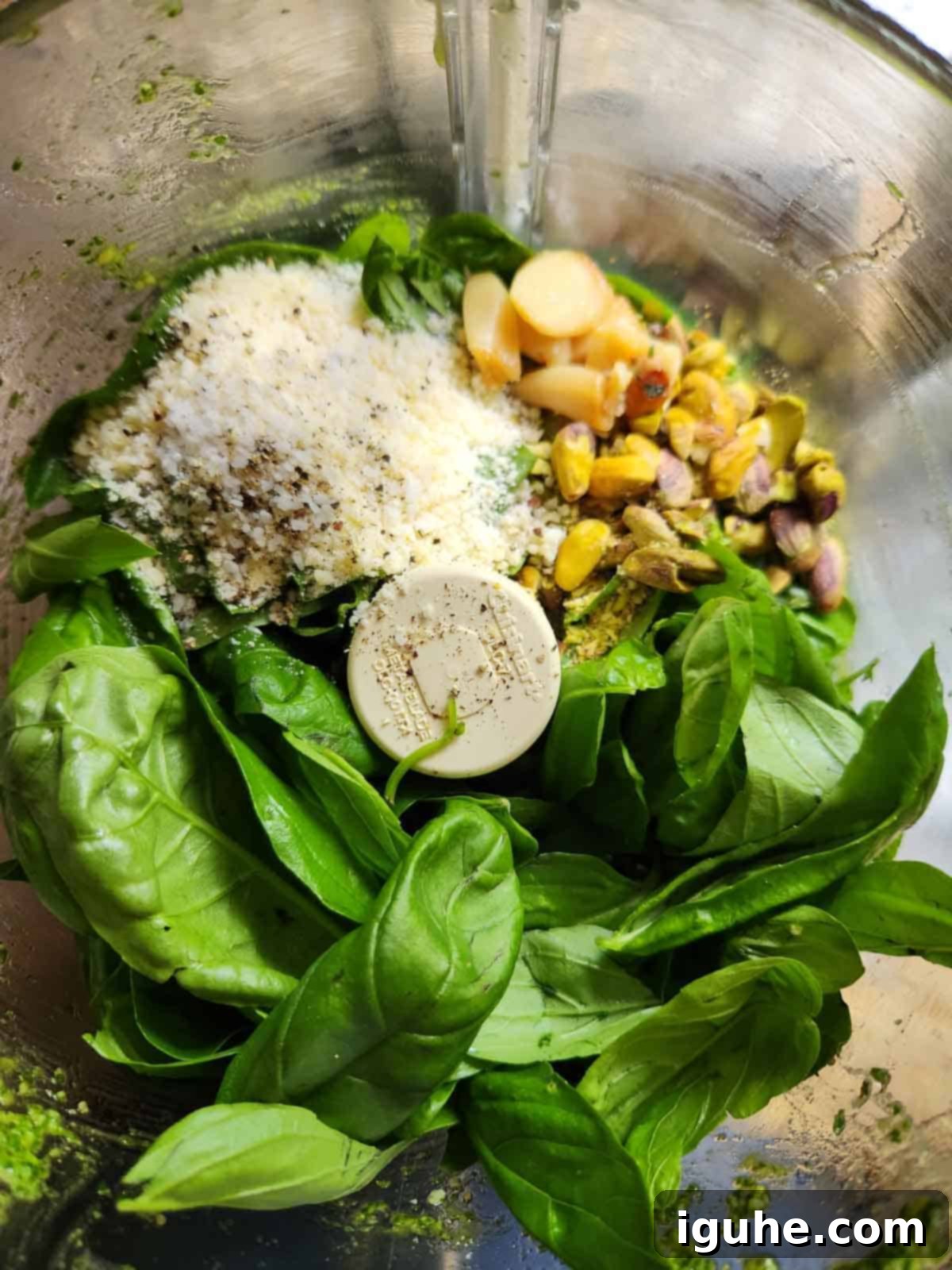
3. Combine Pesto Ingredients: Once the roasted garlic is cool enough to handle, gently squeeze the bottom of the garlic head to release the softened, caramelized cloves. You’ll need about 3 cloves for this recipe, but feel free to adjust to your taste. Add these mellow garlic cloves, along with the fresh basil, grated cheese, pine nuts (or other preferred nuts), and an initial⅓ cup of olive oil, salt, and pepper into your food processor. Pulse on high until all ingredients are well blended and a coarse, sauce-like consistency is achieved. If the pesto appears too thick or chunky, gradually add more olive oil, a tablespoon at a time, while continuing to pulse until you reach your desired smoothness.
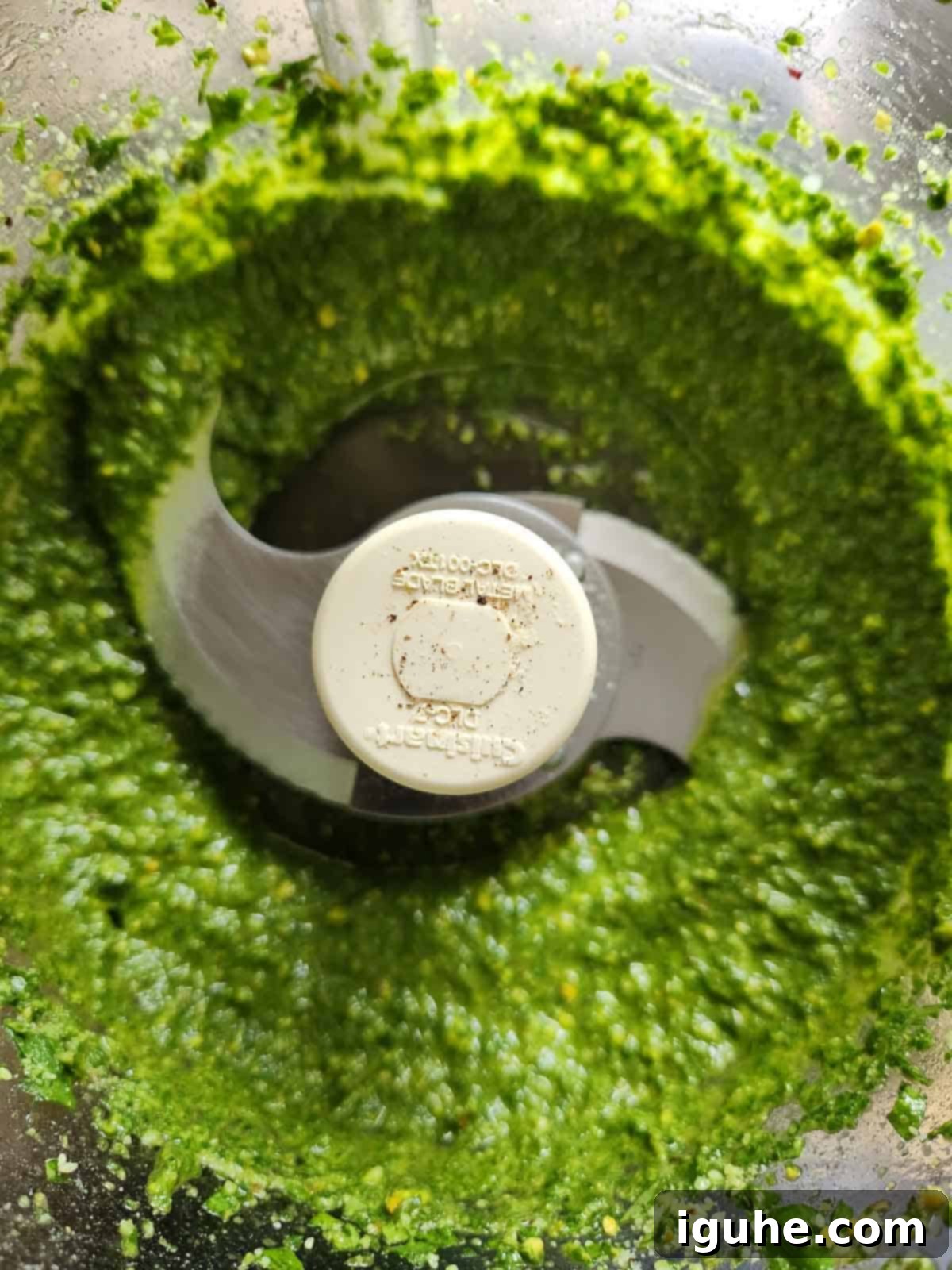
4. Serve and Store: Taste your freshly made roasted garlic pesto and adjust seasoning if necessary. You can serve it immediately or transfer it to an airtight jar for storage. Remember, if you’re planning to freeze your pesto, do not fill your jars to the very top. Leave about a half-inch of space, as the sauce will expand as it freezes, preventing your jars from cracking.
This simple method ensures a rich, flavorful, and perfectly textured roasted garlic pesto every time. Enjoy the process of creating this versatile sauce!
👩🍳Pro Tip for Enhanced Flavor
For an even richer and deeper flavor in your pesto, take a few extra minutes to toast your nuts before adding them to the food processor. You can easily do this in a dry, non-stick pan over medium heat for a few minutes. Make sure to watch them closely and stir frequently, as nuts can burn quickly! This simple step brings out their natural oils and adds a wonderful nutty depth.
Endless Possibilities: How to Use Roasted Garlic Pesto
The versatility of roasted garlic pesto knows no bounds. Its rich, mellow, and savory flavor can elevate a wide array of dishes. Here are just a few ideas to get you started – which one will you try first?
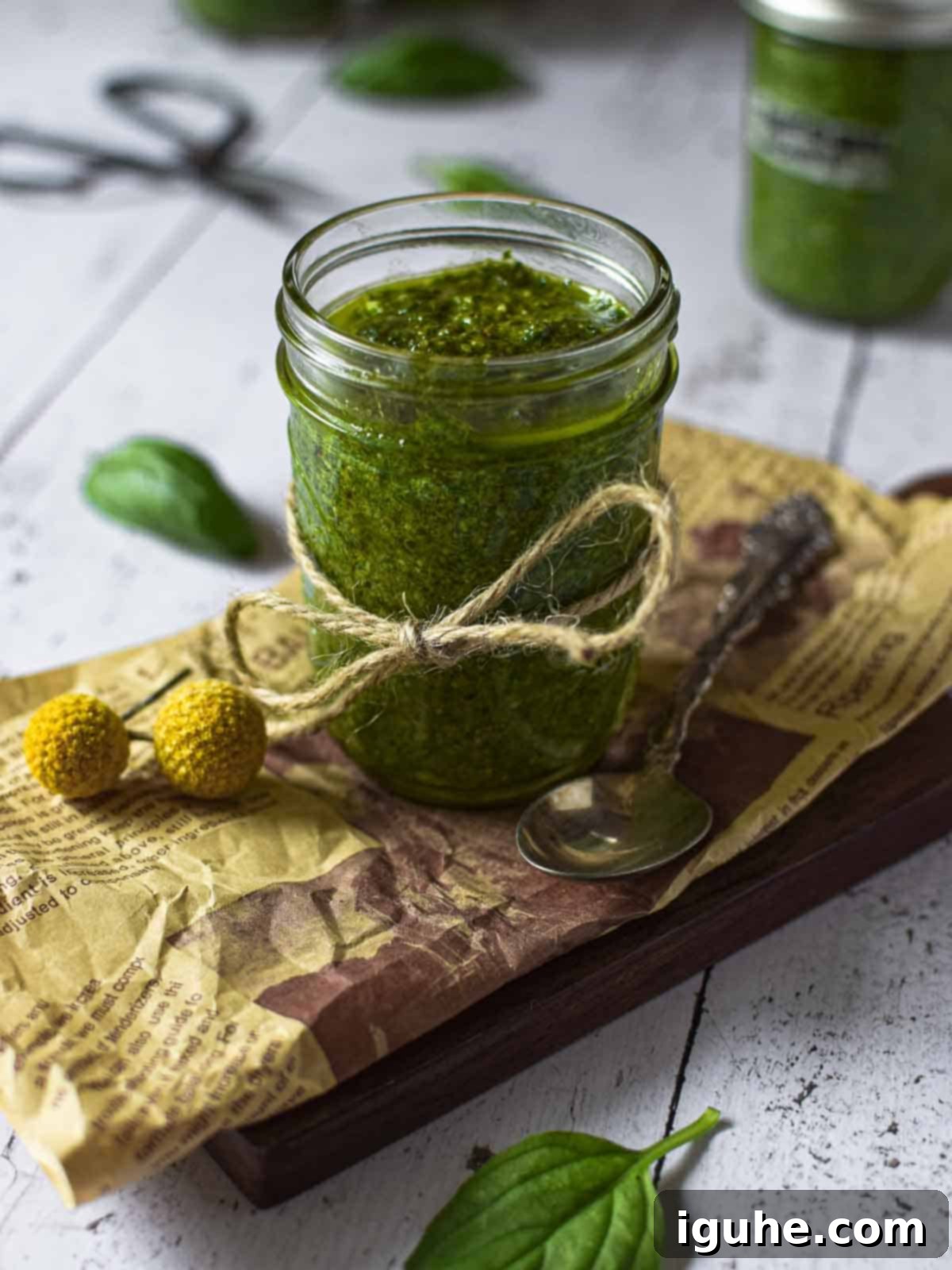
- As a glorious pasta sauce: Toss it with your favorite pasta, adding a splash of pasta water for a luscious coating. It pairs beautifully with everything from spaghetti to fusilli, or even ravioli and gnocchi. Add some cherry tomatoes or grilled chicken for a complete meal.
- Spice up your morning eggs: Swirl a dollop into scrambled eggs, fold it into an omelet, or spread it on toast before topping with a fried egg.
- Add it to sandwiches and wraps: Mix it with softened butter or mayonnaise for a fresh, herbaceous spread that transforms any sandwich, burger, or wrap into a gourmet experience.
- Drizzle on top of pizza: After your pizza comes out of the oven, drizzle fresh pesto over it for a burst of fresh flavor. It’s also excellent as a base sauce!
- Blend it into creamy soups: Stir a spoonful into vegetable, tomato, or minestrone soup just before serving for an extra layer of richness and flavor.
- Elevate the flavor of roasted vegetables: Toss it with asparagus, broccoli, zucchini, or even roasted tomatoes before or after roasting for a vibrant boost.
- Make a delightful pesto dip: Combine with Greek yogurt, sour cream, or cream cheese for a flavorful dip perfect with pita bread, crackers, or fresh crudités.
- Prepare a delicious pesto pasta salad: Mix it into a cold orzo pesto salad or traditional pasta salad for a refreshing side dish.
- Spread on bruschetta or crostini: A simple yet elegant appetizer, topped with fresh tomatoes or mozzarella.
- Marinate grilled meats or fish: Use it as a marinade for chicken, shrimp, or salmon before grilling for an infused flavor.
Creative Variations and Smart Substitutions
One of the beauties of pesto is its adaptability. Don’t be afraid to experiment with these variations and substitutions to make this recipe truly your own:
- Leafy Greens: While basil is classic, almost any flavorful green can be substituted. Try using hearty kale (blanch it first for a brighter green and softer texture), fresh spinach (for a milder taste), peppery arugula, or a combination of greens. You can even explore an Asian-inspired version with cilantro and Thai basil for a unique twist. Always ensure your greens are fresh for the best vibrant flavor and color.
- Nuts: If pine nuts are out of reach, don’t worry! Pistachios offer a subtle sweetness and beautiful green hue, while walnuts lend a slightly more robust, earthy flavor. Pecans can also work, providing a buttery richness. Remember the pro tip: toasting your chosen nuts will unlock a deeper, more aromatic flavor.
- Cheese: Beyond Parmesan, explore other hard, salty cheeses. Locatelli and Pecorino Romano offer a sharper, saltier kick that many pesto enthusiasts adore. You can even use a blend of cheeses to achieve a more complex flavor profile. For a dairy-free or vegan pesto, simply omit the cheese and add nutritional yeast for a cheesy, umami flavor.
- Garlic: This recipe highlights roasted garlic for its mellow, sweet profile. However, if you prefer the traditional sharp kick, you can easily make classic pesto by just skipping the roasting step and using 2-3 cloves of raw garlic, adjusting the quantity to your taste.
- Citrus Zest: A hint of fresh lemon zest can brighten the flavor of your pesto beautifully, adding a zesty aroma.
- Spicy Kick: For those who enjoy a little heat, a pinch of red chili flakes or a tiny bit of fresh chili can be pulsed into the pesto.
- Sun-Dried Tomatoes: For a savory, umami-rich twist, add a few oil-packed sun-dried tomatoes (drained) to your food processor.
Storage Solutions for Freshness and Convenience
Making a big batch of roasted garlic pesto is a smart move, and proper storage ensures you can enjoy its fresh flavor for an extended period. Here’s how to keep your pesto at its best:
Refrigeration: You can store freshly made roasted garlic pesto sauce in airtight containers or tight-fitting jars in the refrigerator for up to one week. To prevent oxidation and keep the pesto vibrant green, a common trick is to pour a thin layer of olive oil over the top of the pesto before sealing the jar. This creates a barrier against air, significantly extending its freshness and preserving its color.
Freezing for Long-Term Enjoyment: Pesto freezes exceptionally well, allowing you to savor summer flavors all year long. When preparing to freeze, transfer the pesto into small freezer-safe jars, freezer bags, or even ice cube trays. If using jars, remember to leave about a half-inch of headspace at the top of the jar because the sauce will expand as it freezes. Once frozen in ice cube trays, you can pop out the pesto cubes and transfer them to a larger freezer bag for compact storage. Freeze for up to 6 months for optimal quality. When you’re ready to use it, simply thaw the pesto in the refrigerator overnight or on the counter for a few hours. Once thawed, give it a good stir and, if desired, freshen it up by adding a little extra virgin olive oil to restore its smooth consistency and vibrant aroma.
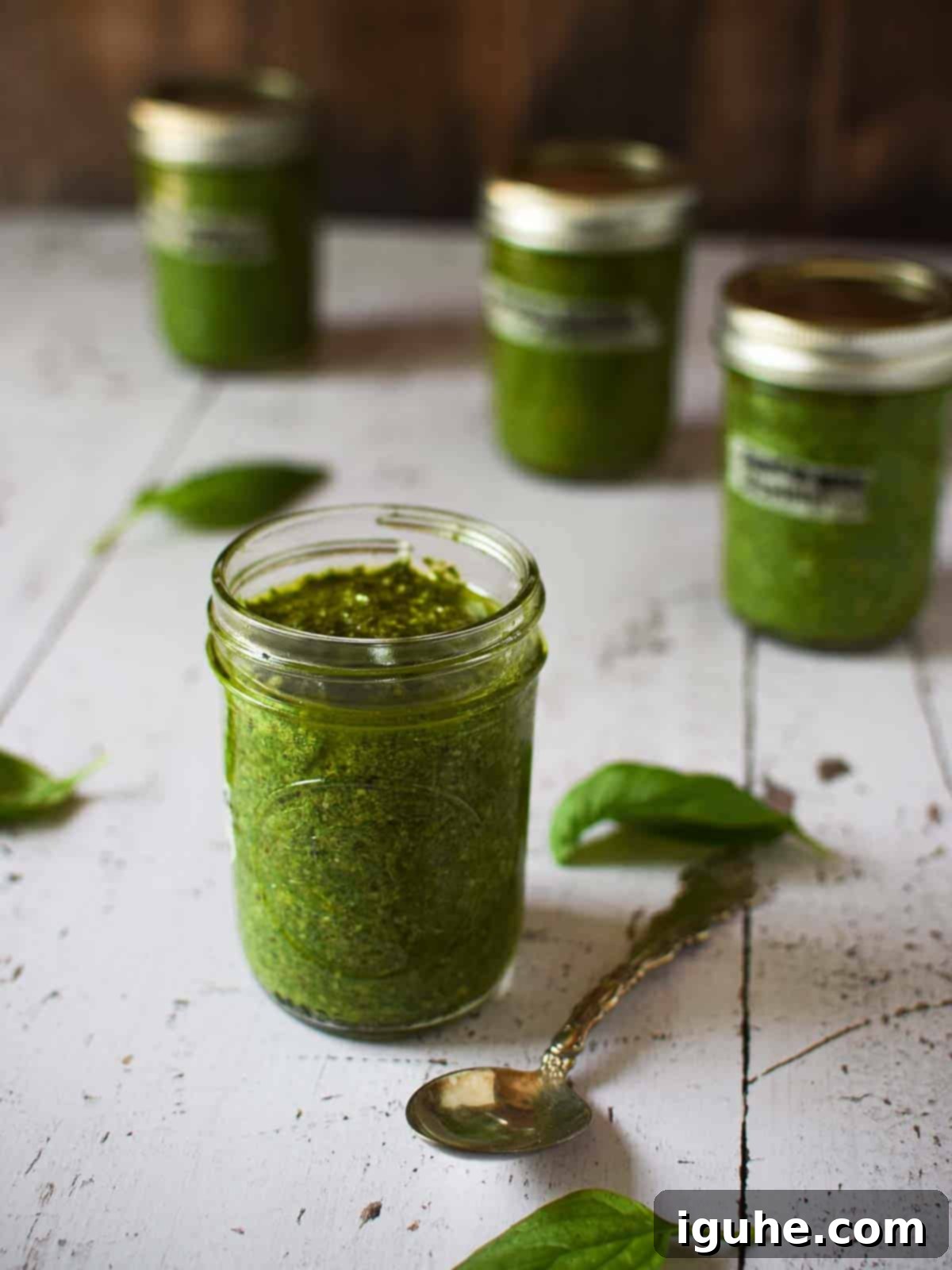
Frequently Asked Questions About Roasted Garlic Pesto
Nope! While roasting the garlic creates a wonderfully mellow, sweet, and creamy pesto, you can certainly make a traditional version by adding 2-3 cloves of raw garlic directly to your food processor instead. Adjust the quantity of raw garlic to your preference for intensity.
You can absolutely make pesto sauce using the traditional method: a mortar and pestle. This method, while more labor-intensive, is believed by some to produce a superior flavor and texture by gently crushing the ingredients rather than chopping them with blades. Just be prepared for a good arm workout!
Pesto can turn brown due to oxidation when the basil is exposed to air. To prevent this, ensure your pesto is tightly sealed in an airtight container. When storing in the refrigerator, pour a thin layer of olive oil over the surface of the pesto before sealing to create an oxygen barrier. For freezing, consider pressing plastic wrap directly onto the surface before sealing.
Yes, absolutely! To make this recipe vegan, simply omit the Parmesan cheese. For a cheesy flavor substitute, you can add 1-2 tablespoons of nutritional yeast to the food processor. It provides a savory, umami depth without any dairy.
More Delicious Italian-Inspired Recipes
Looking for other delightful Italian recipes to expand your culinary repertoire? Explore these fantastic options:
- Sicilian Eggplant Caponata
- Easy Lemon Pizzelle
- Roasted Red Pepper Pesto
- Panettone Pizzelle
And for those with a sweet tooth, don’t miss my classic pignoli cookies, decadent Panettone bread pudding, or the silky smooth espresso coffee panna cotta for the perfect Italian sweet treat.
Did you make this recipe? I would love to hear about it! Please leave a ⭐⭐⭐⭐⭐ rating with a comment right below the recipe card. If you snap a photo of your creation, don’t forget to tag me on Instagram @brunchandbatter.
📖 Recipe
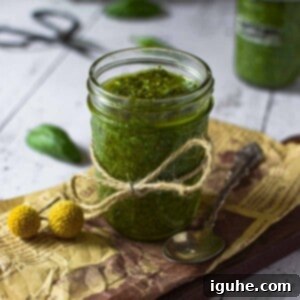
Roasted Garlic Pesto Sauce
Prevent your screen from going dark
Pin Recipe
10 minutes
50 minutes
1 hour
Main Course
Italian
1
cup (half pint, 8 ounces)
211
kcal
Equipment
-
aluminum foil
-
food processor
Ingredients
Roasted Garlic
-
1
head
garlic - olive oil for drizzling
Roasted Garlic Pesto Sauce
-
4
cups
fresh basil, loosely packed -
3
cloves
roasted garlic -
⅓
cup
grated parmesan cheese -
¼
cup
pine nuts -
⅓-½
cup
olive oil -
¼
teaspoon
Kosher or fine sea salt -
¼
teaspoon
fresh ground pepper
Instructions
Roasted Garlic
-
Preheat the oven to 425℉ (220℃). Remove the papery outer layer from the garlic head, leaving it mostly intact. Using a knife, cut about ¼-½ inch off the tops of the garlic to expose the cloves. Drizzle with olive oil to coat, and wrap the garlic snugly in aluminum foil. Place directly on the oven rack or a small baking pan, and roast for 40-50 minutes until the cloves are golden brown, soft, and caramelized. Set aside and allow to cool slightly before handling.1 head garlic,
olive oil for drizzling
Roasted Garlic Pesto Sauce
-
Once the roasted garlic has cooled, carefully squeeze the garlic head to extract about 3 cloves of the softened, caramelized garlic. Add these cloves along with the fresh basil, grated parmesan cheese, pine nuts, and an initial ⅓ cup of olive oil to a food processor. Pulse on high until all ingredients are well blended and a thick, chunky sauce forms. Gradually add more olive oil (up to ½ cup total) as needed, pulsing until you achieve your desired smooth, sauce-like consistency. Season to taste with additional salt and fresh ground pepper if desired.4 cups fresh basil, loosely packed,
⅓ cup grated parmesan cheese,
¼ cup pine nuts,
3 cloves roasted garlic,
⅓-½ cup olive oil,
¼ teaspoon Kosher or fine sea salt,
¼ teaspoon fresh ground pepper
Notes
To freeze: Place pesto in freezer-safe jars (leaving ½ inch headspace) or ice cube trays. Store in the freezer for up to 6 months. Thaw in the refrigerator and stir in a little fresh olive oil if needed to refresh.
Nutrition*
Serving:
2
tbsps.
Calories:
211
kcal
Carbohydrates:
2.2
g
Protein:
5.4
g
Fat:
21.2
g
Saturated Fat:
4
g
Cholesterol:
7
mg
Fiber:
0.5
g
Sugar:
0.4
g
Calcium:
150
mg
Iron:
1
mg
*Nutrition information is provided as a courtesy and is an estimate only. Nutrition information can vary depending on many factors, such as products used, measurements and substitutions, therefore it is recommended that you obtain nutritional calculations based on your own finished recipe.
Have you tried this recipe?
Leave a comment below and share a photo on Instagram. Tag @brunchandbatter or hashtag it with #brunchandbatter
